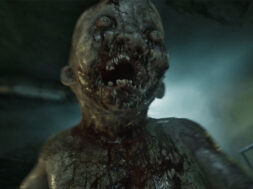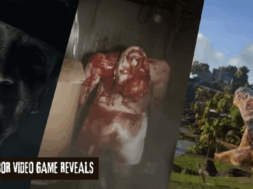While Found-Footage films are no longer raking in at the box-office like the good-old-days, you can’t deny the impact that this humble little sub-genre has had on contemporary horror. Films like The Blair Witch Project and Paranormal Activity became pop-culture icons and wound up influencing a whole new generation of media. From comic-books to television shows, there are few areas yet untouched by at least some Found-Footage tropes, but there is one medium that usually goes unmentioned when discussing this sub-genre. That would be the world of videogames.
While literal Found-Footage games are admittedly rare (which makes sense, considering that the premise relies on the discovery of pre-recorded media, leaving little room for interaction), there are actually quite a few titles that make use of Found-Footage elements in order to ground their narratives and gameplay, and I’d like to talk about them today. To make things simple, we’ll consider any game that features an organized collection of diagetic (in-universe) media as Found-Footage-inspired, regardless of POVs and setting.
In any case, videogames have been emulating movie trends from the very beginning, so it was only a matter of time before home-video-inspired thrills became interactive. In fact, long before Bloober Team’s recent attempt at bringing the Blair Witch to life for modern gamers, we actually had a trilogy of officially licensed Blair Witch games, though none of them really bothered with the Found-Footage aspect of the story.
However, it was really during the PS2 era that developers began to experiment with the idea of using Found-Footage tropes in order to enhance gameplay. Oddly enough, most of these titles were produced in Japan, and some of them never even made it to Western shores at all, but there are definitely a few hidden gems among them.
One of my favorites of these oddball titles is Lifeline, a 2003 survival horror game developed by Sony’s in-house studio for the PS2. In the game, players take on the role of a young Operator trapped in a space-station’s control center when horrific monsters attack. What’s unusual here is that almost the entire game is viewed through diagetic security-camera footage, and the player can only interact with the world by communicating through a physical headset with a cocktail waitress named Rio, giving her simple commands in an effort to progress through the story. While I’ll be the first to admit that console technology wasn’t quite ready for these ambitious ideas back in ’03, the combination of spooky security footage and limited controls manage to make this a genuinely thrilling experience that wouldn’t have been as engrossing if it weren’t for the grounded aesthetics. It’s just too bad that players are forced to deal with so many frustrating quirks if they really want to power through the entire game.

There was a game for everyone back in the PS2 era, wasn’t there?
Naturally, this wasn’t the only case of diagetic cameras in gaming, as Michigan: Report From Hell, another PS2 title developed by Grasshopper Manufacture and released in 2004, actually put players in the shoes of a cameraman accompanying a news crew on a terrifying investigation. Not only was the entire game observed through the viewfinder of the protagonist’s camera, but gameplay is also mostly relegated to tagging important objects or events and waiting for other characters to interact with them. Again, this title also has its fair share of gameplay annoyances, but it’s one of the better (and earliest) examples of an almost pure Found-Footage experience in gaming.
While there were a few more obscure attempts at bringing Found-Footage to interactive life during the 2000s, it was only with the indie-horror boom of the last decade that this type of aesthetic became mainstream. The 2010s brought us a plethora of Found-Footage web-series (not to mention the Paranormal Activity sequels), so it was only natural that developers would start to experiment more with diagetic cameras and ill-fated protagonists leaving their stories behind for players to find. Hell, one could even argue that the now cliché idea of finding audio-logs in to understand the narrative in blockbuster titles was also influenced by these ideas, though they were only properly explored in the indie scene.
The biggest of these Found-Footage-inspired indie titles was probably Slender: The Eight Pages, a free-to-play game more than a little inspired by the Marble Hornets web-series. Released in 2012 to massive viral success, the game was basically a first-person adaptation of hide-and-seek, with the player attempting to find the titular pages while being stalked by the infamous Slender Man. While the game doesn’t overtly advertise itself as a Found-Footage endeavor, the static interference onscreen when in the presence of the antagonist suggests that we may be viewing the action from a camcorder. This is more-or-less confirmed in the game’s sequel, Slender: The Arrival, which fully dives into the Found-Footage genre with a visible camera HUD and playable “tapes” (this makes sense, given that the game was co-written by the same team that originally produced Marble Hornets).
By 2013, we would also get one of the most brutal Found-Footage experiences in gaming with Red Barrels’ Outlast (a title almost certainly inspired by the Vicious Brothers’ 2011 film, Grave Encounters). In this game, players take on the role of Miles Upshur, a journalist investigating increasingly suspicious activity going on at Mount Massive Asylum. Naturally, he becomes trapped in the hospital after breaking in with a camcorder and must attempt to escape (and document) the horrors within in a truly nightmarish ordeal.

Well, I sure won’t be sleeping tonight.
While you’re not limited to the camera’s viewfinder for the entirety of the game (you’re actually separated from it in at least one instance), the narrative and aesthetics here are clearly based on traditional Found-Footage tropes. The camera isn’t just there for show, though, as it also boasts a night-vision feature if you can spare the battery power. The camera’s functions would also get expanded on in the game’s 2017 sequel, but I still think it’s a shame that the full experience isn’t presented as a series of diagetic recordings.
Regardless, Outlast was influential enough that it even had an impact on Capcom’s flagship survival horror franchise, Resident Evil. While 2017’s RE7 isn’t as obvious with its Found-Footage roots, there are several instances within the game where players must analyze footage left behind by other characters, as well as record some of their own in clear homages to the sub-genre. This may not be a consistent addition to the gameplay, but it’s nice to see these elements being played around with in order to heighten the game’s realism and, consequently, scare-factor.
Despite Found-Footage clearly being a great tool in the manipulation of fear, I think one of the best (and purest) examples of the sub-genre successfully transitioning to gaming isn’t even a horror title. In Sam Barlow’s 2015 investigative thriller Her Story, players are tasked with piecing together a murder mystery as they analyze police interviews regarding a certain Hannah Smith and her deceased husband. The gameplay itself is relegated to navigating 90s-inspired computer menus and interacting with a collection of FMVs and other digital “evidence” in order to find out what’s really going on. While Her Story may not be for everyone, I think it’s one of the most underrated releases of the 2010s, and it also boasts a format that I’d love to see revisited by future games (especially spooky ones).
Of course, we’d be remiss if we didn’t take a moment to discuss Bloober Team’s hot new take on the Blair Witch. Taking place in 1996, players must wander the Black Hills Forest as Ellis Lynch, a retired police officer and military veteran searching for a missing child as he deals with severe PTSD. Luckily, Ellis is accompanied by a faithful canine companion (Bullet, my favorite part of the game) and, eventually, a mysterious camcorder that can be used to review reality-altering tapes. While this 2019 title has a lot in common with Layers of Fear, the studio’s previous foray into the horror genre, interactions with both the dog and camera actually make this a unique experience, with players relying on elements outside of their immediate control in order to survive.
Like many of the previously mentioned titles, Blair Witch has some frustrating quirks and could have used a bit more time to iron out the bugs and unfocused storyline. Nevertheless, the final hour or so of the experience serves as a sincere love-letter not just to the original Blair Witch Project but to Found-Footage as a whole, becoming a perfect example of how the use of shifting POVs and messy, realistic aesthetics can be used to create a genuinely terrifying experience.

If only the rest of the game could compare to the ending.
Of course, these aren’t the only Found-Footage-inspired games out there (I could go on for hours about the Five Nights at Freddy’s franchise and its extremely effective use of diagetic security cam footage), but I think these titles help paint a picture of a gaming industry slowly experimenting with the gritty aesthetics of this sub-genre and contemplating what it can do for gameplay and story alike. In a time where gamers are craving new experiences, it’s nice to see developers taking risks by incorporating new ideas into their games, even if they’re not always successful.
As we speak, indie developers like Puppet Combo are hard at work attempting to revive the 90s VHS aesthetic in horror games, complete with several Found-Footage-inspired titles. Funnily enough, we’ve also come full circle with games managing to influence films like Livescream, a Found-Footage production about an ill-fated internet personality livestreaming a cursed videogame. Even the Paranormal Activity franchise’s latest entry was actually a VR title instead of a movie (though it technically forgoes the Found-Footage elements in favor of more traditional first-person horror mechanics).
While I think the definitive Found-Footage game has yet to be developed, we’re getting closer to it everyday, and I can’t wait to see what the future brings for this little sub-genre that could.









